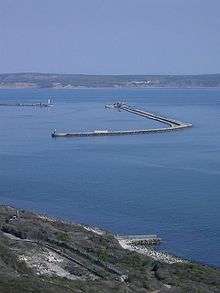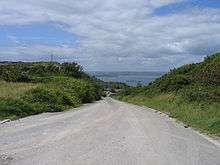HMS ''Osprey'', Portland

HMS Osprey was an anti-submarine training establishment located at the Isle of Portland, Dorset, England. It was active between 1924 and 1941, and again from 1946 to 1995. The helicopter station RNAS Portland shared the same name from 1959 and closed in 1999.
The original anti-submarine school later became known as the Underwater Detection Establishment after World War II. In 1959, it was merged into the Admiralty Underwater Weapons Establishment, which also included the Admiralty Gunnery Establishment near the village Southwell. The Underwater Detection Establishment remains infamous for the espionage infiltration of the Portland Spy Ring. Over the decades scientists at Portland became world pioneers in underwater warfare and detection. Portland's research focused on underwater weapons, from ASDIC and sonar in the 1920s to acoustic homing Stingray torpedoes in the 1980s.[1]
History
Creation of shore-based establishment and World War II (1924–1945)

HMS Osprey was originally the command ship of the First Anti-Submarine Flotilla, commissioned in Portland Harbour to run the Royal Navy Anti-Submarine School on 1 April 1924.[2][3] The harbour had first become an important site for research since Robert Whitehead established his Torpedo factory at Ferrybridge in 1891 to manufacture and test torpedoes.[4]
The First World War saw the initial development of such anti-submarine equipment as depth charges, howitzers and hydrophones. With the increasing need for anti-submarine research, the HMS Osprey establishment was moved onto land in 1927 as a shore-based establishment. It was involved in ASDIC and sonar development.[2][3] Following a major rebuild, King Edward VIII made an official visit to view the establishment in 1936.[5] Due to HMNB Portland being a prime target of the Luftwaffe during World War II,[6] Osprey was transferred to Dunoon in Scotland, leaving Portland's shore-base to become HMS Attack.[7]
Role in Cold War (1946–1959)
HMS Osprey returned to Portland in 1946, with the anti-submarine school become HM Underwater Detection Establishment in 1947.[8] In 1959, it merged with Portland's Admiralty Gunnery Establishment to become the Admiralty Underwater Weapons Establishment (AUWE). It was named AUWE(N), with the former Gunnery Establishment being AUWE(S).[9] That same year saw the commissioning of RNAS Portland (HMS Osprey), which was formed to assess the potential of anti-submarine helicopters.[2]
The research at Portland had the highest security classification at the height of the Cold War.[10] However, in 1961, Portland became the centre of worldwide attention after the discovery of the espionage infiltration of the Portland Spy Ring, which had been operating since the late 1950s. It is one of the most famous examples of the use of illegal residents — spies who operate in a foreign country but without the cover of their embassy.
Of the five arrests made in January 1961, two of the ring were local residents Henry Houghton and Ethel Gee. The pair both worked for the Admiralty and had met and formed a relationship through.[11] As Gee had access to secret material, Houghton was able to hand over information to Soviet intelligence officer Gordon Lonsdale in exchange for money. The pair made regular trips to London in order to hand over information to Lonsdale, who in turn would send the information to the USSR via a bungalow in Ruislip. The residence belonged to Peter and Helen Kroger, who themselves were on the FBI's wanted list regarding connection to a similar espionage case.[12]
A trial at the Old Bailey in March 1961 saw Gee affirm her innocence, where she openly admitted that naivety caused her to play her role, with Houghton being a long-awaited love to "sweep her off her feet". Houghton would later state that Gee did not have a full grasp of the understanding relating to the tasks he had asked her to carry out.[11] Houghton's reasoning at the trial was that he had been blackmailed by the Poles and the Russians into spying for them, and that the information he gave them were already in the public domain.[13] At the end of the trial Lonsdale was given a sentence of 25 years, the Krogers given 20 years, while Houghton and Gee were both sentenced to 15 years imprisonment. Lonsdale did not serve much of this sentence, as in April 1964, he arrived in Berlin to be exchanged for the British spy Greville Wynne. In 1969 the Krogers were also exchanged - for the lecturer Gerald Brooke. Houghton and Gee served 10 years of their sentences, and were released in 1971, where they soon married and changed their names. Houghton later wrote an autobiography, titled Operation Portland, which was published in 1972.[11]
Continued operations and eventual closure (1960s–1995)
From 1968, HMS Osprey was one of the designated locations for plan PYTHON, the plan for continuity of government in the event of nuclear war.[14] RDV 01 Crystal, an unpowered floating research vessel, was situated in Portland Harbour for a number of years. It was designed to be used during sonar research and development projects at the Admiralty Underwater Weapons Establishment. It was launched in 1971 and sold in 1992 to a Dutch concern.[15]
Following the ending of the Cold War, the closure of HMNB Portland and its research establishments was announced as part of defence budget cuts. In 1995 the Royal Navy departed the base, while the buildings were also vacated.[16] Once the closure of the naval base and establishments had been completed, RNAS Portland's closure followed on 31 March 1999. The research carried out at Portland, now under the Defence Evaluation and Research Agency (DERA) since 1995, was relocated to the Atomic Energy Agency's business park at Winfrith, leaving Bincleaves as the sole establishment in the Portland Harbour area.[17] During the late 1990s, it was decided to convert the HMS Opsrey complex at East Weares into a holiday village.[18] These plans were set, but did not come to fruition. The Southwell complex became the Southwell Business Park in 1997, while the East Weares complex was demolished in 2004-05 by Portland Port Ltd, the new owners and operators of the harbour.[19]
References
- ↑ Morris, Stuart (1998). Discover Dorset: Portland. Dovecote Press. p. 60. ISBN 978-1874336495.
- 1 2 3 Legg, Rodney (1999). Portland Encyclopaedia. Dorset Publishing Company. p. 82. ISBN 978-0948699566.
- 1 2 "Why Portland's naval base was called HMS Osprey (From Dorset Echo)". Dorsetecho.co.uk. Retrieved 2015-06-23.
- ↑ "The Jurassic Coast - Underwater Research". jurassicagent.co.uk. Archived from the original on 2014-07-26. Retrieved 2014-07-17.
- ↑ Morris, Stuart (1985). Portland: An Illustrated History. Dovecote Press. p. 141. ISBN 978-0946159345.
- ↑ "World War 2". Geoffkirby.co.uk. Retrieved 2015-06-23.
- ↑ Scribbles. "Royal Navy Pay and Conditions". Freepages.genealogy.rootsweb.ancestry.com. Retrieved 2015-06-23.
- ↑ https://www.gov.uk/government/uploads/system/uploads/attachment_data/file/325766/Dstl_s_history.pdf
- ↑ "Admiralty and Ministry of Defence: Underwater Weapons Establishment, later Admiralty Underwater Weapons Establishment: Reports and Technical Notes | The National Archives". Discovery.nationalarchives.gov.uk. Retrieved 2015-06-23.
- ↑ "A Portland Success Story | Dorset Life - The Dorset Magazine". Dorset Life. Retrieved 2014-07-17.
- 1 2 3 "The Spy Next Door - People - Dorset". Dorsetmagazine.co.uk. Retrieved 2015-06-23.
- ↑ "MI5 man broke island spy ring (From Bournemouth Echo)". Bournemouthecho.co.uk. Retrieved 2015-06-23.
- ↑ Polmar, Norman; Allen, Thomas B. (1997). Spy Book - The Encyclopedia of Espionage. Greenhill Books. ISBN 1-85367-278-5.
- ↑ "If nuclear war had broken out between Russia and the west, HMS Osprey on Portland would have been a remote hideaway for the government". Dorset Echo. 28 January 2017.
- ↑ "RDV 01 Crystal". World Naval Ships Directory. 2012. Retrieved 29 June 2012.
- ↑ "A Portland Success Story | Dorset Life - The Dorset Magazine". Dorset Life. Retrieved 2015-06-23.
- ↑ "Archived copy". Archived from the original on 2014-07-26. Retrieved 2014-07-17.
- ↑ Morris, Stuart (1998). Discover Dorset: Portland. Dovecote Press. p. 63. ISBN 978-1874336495.
- ↑ "YOI and Caves on Portland, Dorset". Geoffkirby.co.uk. Retrieved 2015-06-23.